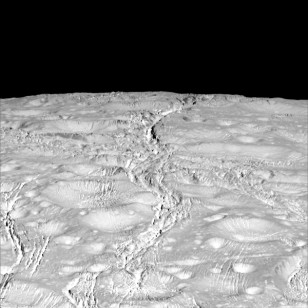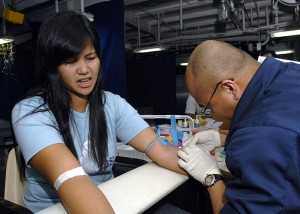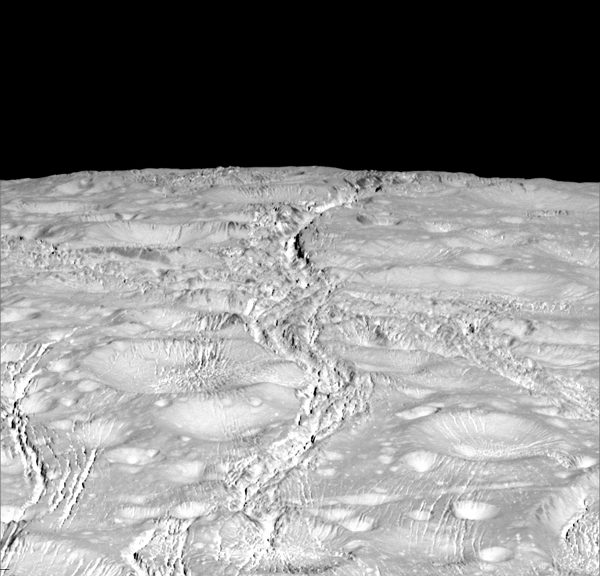
NASA’s Cassini spacecraft zoomed by Saturn’s icy moon Enceladus on Oct. 14, 2015, capturing this stunning image of the moon’s north pole. (NASA/JPL-Caltech/Space Science Institute)
Cassini Explores North Pole Area of Saturn’s Moon Enceladus
NASA’s Cassini spacecraft has been sending back spectacular images and providing scientists with valuable data about the Saturn and its many moons since its arrival there in 2004.
On October 14th, Cassini returned to Saturn’s ice-covered and 6th largest moon Enceladus, the latest of many trips since 2005.
This time, the spacecraft sent back high resolution images of the moon’s northern region.
The scientists were quite surprised by what they saw.
Based on images taken by the 1970’s Voyager Mission, they thought the region would be heavily cratered.
NASA says Enceladus’ northern landscape is crisscrossed by a spidery web of delicately-thin cracks that have cut through its surface.
The Cassini is set to do its closest flyby of the moon’s southern polar region on October 28th and will make its final targeted pass of Enceladus on December 19th. NASA says that the Cassini Mission is scheduled to end in 2017.

Stanford chemical engineering Professor Zhenan Bao and her team have created a skin-like material that can tell the difference between a soft touch and a firm handshake. (Bao Lab)
Scientists Create Artificial Skin That Can Sense Pressure
Over the past few years, researchers have made tremendous strides in making prosthetic hands more lifelike.
While scientists are getting close to making artificial hands perform as well as natural hands, one area that remains a challenge is replicating the sense of touch.
Engineers at California’s Stanford University answered that challenge and have created a plastic “skin” that can detect how hard it is being pressed and then produce an electric signal that will provide that sensory response directly to a living brain cell.
This newly created artificial skin will allow users to be able to detect the pressure difference between a light finger tap and a firm handshake.
The skin is made with two layers of plastic. The top layer acts as an input device that senses the touch and the intensity of the touch. The bottom layer is like an electronic circuit board that processes electrical signals and converts them into a biochemical stimuli that are compatible with nerve cells.

President Barack Obama gives his first inaugural address from the West Steps of the U.S. Capitol on January 20, 2009. The record setting event attracted more than 800,000 people. (US Air Force)
Florida Researchers Create Automated Crowd Counting System
Anyone who has done a head count at a large gathering knows how frustrating and monotonous this task can be.
Now, imagine you’re working for a large corporation or government agency and you need to determine how many people participated in an event that attracted thousands of people.
The long and boring process usually involves people who examine aerial photos of the crowd. The photos may be overlaid with a grid of cells a couple of centimeters square. Then one cell at a time, the counters tally the number of heads per cell.
Researchers at the University of Central Florida have now come up with an automated crowd counter.
The software they created allows a computer to scan aerial photographs and then count the number of people in the images automatically.
The researchers say that what had once taken a week to complete can be done in as little as 30 minutes giving organizers of large events more time to develop a crowd management plan.

Young woman expresses her aversion to getting jabbed with a needle as a medical technician draws blood (US Navy)
New Blood Test Let Doctors Create Patient Specific Cancer Treatments
British researchers say they’ve come up with a new blood test that could help doctors provide cancer patients with the most appropriate treatment for their particular disease.
By running these new blood tests at times throughout a patient’s treatment medical professionals will be able to quickly and easily monitor the cancer’s progress to see if the selected therapy is working or if a new plan should be devised.
The researchers say their new blood test filters out a tumor’s DNA from a patient’s blood, which then can be analyzed for genetic defects.
The results of the test will allow doctors to match up the defects with specific cancer treatments which will then go after and attack the cancer cells containing the flawed DNA.
The scientists say that since cancer tumors and their genetic makeup are unique and evolving, doctors need to understand these changes so they can develop the best treatment possible for their patients.























Comments are closed.